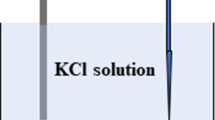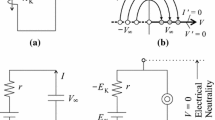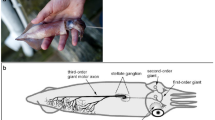Abstract
Very different biophysical theories can lead to similar or even identical predictions for a wide range of experiments. This was true for the original Rashevsky theory of membrane excitation, and the later Hill formulation. Similarly, the Hodgkin-Huxley equations for membrane current are based on two postulates: current proportional to total thermodynamic potential difference across the membrane, and the independence principle. Experiments used to confirm these postulates can be predicted as well by a model in which neither postulate applies.
Similar content being viewed by others
Literature
Blair, H. A. 1932. “On the Intensity-Time Relations for Stimulation by Electric Currents. I.”J. Gen. Physiol.,15, 709–729.
Cole, K. C. and J. W. Moore. 1960. “Potassium Current in the Squid Giant Axon: Dynamic Characteristics.”Biophys. J.,1, 1–14.
Hill, A. V. 1936. “Excitation and Accommodation in Nerve.”Proc. Roy. Soc. London, Series B,119, 305–355.
Hodgkin, A. L. and A. F. Huxley. 1952. “A Quantitative Description of Membrane Current and its Application to Conduction and Excitation in Nerve.”J. Physiol. (London),117, 500–544.
Hoyt, Rosalie. 1971. “Independence of the Sodium and Potassium Conductance Channels. A Kinetic Argument.”Biophys. J.,11, 110–122.
Offner, F. 1937. “Excitation Theories of Rashevsky and Hill.”J. Gen. Physiol.,21, 89–91.
Offner, F. 1969. “Interface Kinetics in Excitable Membranes.”Abstracts of the 3rd International Biophysical Congress of the International Union for Pure and Applied Biophysics. Cambridge, Mass., p. 95.
— 1970a. “Diffusion Theory of Axonal Excitability.”Biophys. Soc. Abs.,10, 111a.
— 1970b. “Kinetics of an Excitable Membrane. Voltage Amplification in a Diffusion Regime.”J. Gen. Physiol.,56, 272–296.
— 1971a. “Nernst-Planck-Poisson Diffusion Equation: Numerical Solution of the Boundary Value Problem.”J. theor. Biol.,31, 215–227.
Offner, F. 1971b. “Theory of Ionic Diffusion Through Excitable Membranes.”24th Annual Conf. on Engineering in Medicine and Biology, p. 116 (abs.).
— 1972. “The Excitable Membrane—a Physiochemical Model.”Biophys. J.,12, 1583–1629.
Rashevsky, N. 1933. “Outline of a Physico-chemical Theory of Excitation and Inhibition.”Protoplasma,20, 42–56.
Author information
Authors and Affiliations
Rights and permissions
About this article
Cite this article
Offner, F.F. The excitable membrane-biophysical theory and experiment. Bltn Mathcal Biology 35, 101–107 (1973). https://doi.org/10.1007/BF02558799
Issue Date:
DOI: https://doi.org/10.1007/BF02558799




